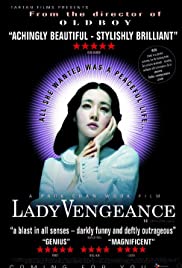
LADY VENGEANCE/ SYMPATHY FOR LADY VENGEANCE
Korea, 2005, 112 minutes, Colour.
Directed by Chan-wook Park.
One of the features of Korean cinema for almost the last ten years is that it has gone beyond martial arts to a proliferation of violent vengeance thrillers. Kim Ki Duk was an exponent of this kind of film before he moved to more contemplative dramas and thrillers. Kim Jee-woon does it all very stylishly so that you could feel quite guilty watching the ingenuity and style of a gangster film like A Bittersweet Life. Chan-wook Park has a worldwide reputation as well as at home. After making what looks like the beginnings of a trilogy with Sympathy for Mr Vengeance in 2001, he won the jury prize at Cannes, 2004, when (probably no surprise to see this) Quentin Tarantino headed the Jury with Old Boy. Now comes a third film, Lady Vengeance (chosen for the competition in Venice, 2005). It is stylish, thoughtful, violent.
Best to quote the director himself on his themes and gauge whether his words accurately describe his films. The main character in Old Boy says, ‘Seeking revenge is the only cure for someone who has been hurt”. The presumption is that this is the director’s own view. He says, emphatically, that it is not. ‘My view of vengeance has not changed… I still think it is the most foolish thing you can do. Revenge will do nothing to bring back what you have lost. It’s quite a simple concept, even children understand it, but adults, and sometimes even whole states, seem compelled to engage in these acts of violence’.
In the films, the central character has been cruelly victimised by an unscrupulous enemy. Old Boy has been incomprehensibly imprisoned for years and finds himself suddenly set loose and let loose. Lady Vengeance has spent thirteen years in prison, seeming the angel of kindness while all the time harbouring deep resentment and forming a network of fellow prisoners who will aid here when she is set loose and will pursue the man who destroyed her life. She meticulously goes about her plan. She was imprisoned for abducting and killing a child. The real killer has, meanwhile, killed again and again. Lady Vengeance assembles the grieving parents, along with the powerless police inspector, and tells them that the law will not do them justice. What follows is a horrific, almost ritual killing – although it is in the same vein, really, as Agatha Christie’s Murder on the Orient Express.
Where Lady Vengeance illustrates the director’s stance on the futility and the personal destructiveness of vengeance is in the use of the classical musical score and the times of quiet that the audience are given where they have an opportunity to get over the adrenalin rush or the horrified reaction and sit and contemplate what they have seen and felt before they leave the theatre. The revenge tragedy was a feature of the bloodthirsty era of Elizabethan and Jacobean times (think Hamlet). What does the revenge tragedy in Asian films say about our times?